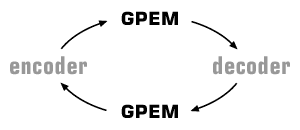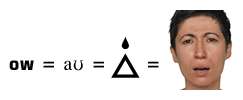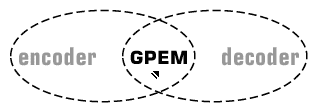
|
Dictionary of Primal BehaviourInternet Database and Digital Prints
|
- Photo doc
 Essay:
Essay:
The Primal Chat- + more
 Excerpt from Graham Pullin's book
Excerpt from Graham Pullin's book-
Art and Language
A database of phonetically expressive words transferred into visual codes
-
Keywords / Tags
- Database art,
- Language,
- Entropy,
- Primary emotions,
- Emotion,
- Expression,
- Facial expression,
- Affective communication,
- Dictionary,
- Interjection,
- Nonverbal,
- Code,
- Information,
- Message,
- Symbol,
- Meaning,
- Aesthetic communication,
- AAC - augmentative and alternative communication,
- Disability
Art-Bio:
Awards
- 2003
- UNESCO Digital Arts Award 2003 at IAMAS, Japan
- Award at “MAD 03” 2nd meeting of experimental art in Madrid, Spain
- The annual award of the gallery Golden Eye “The exhibition of the year”, Novi Sad, Serbia and Montenegro
Festivals and Group Exhibitions
- 2004
- Ogaki, Japan, Ogaki Biennale 2004, (IAMAS)
- 2003
- Holon, Israel, “Hilchot Shchenim”, The Israeli Center for Digital Art
- Basel, Switzerland, “Viper”, International Festival for Film, Video and New Media, Basel
- Belgrade, SCG, “WLI” World, Language, Iconicity - group exhibition and symposium, Rex B92 Cultural Center
- Madrid, Spain, “MAD 03” 2nd meeting of experimental art in Madrid
- Belgrade, SCG, “POSITIVE / NEGATIVE”, 44th October Salon
- Novi Sad, SCG, “Balkan video&digital art Festival”, solo exhibition at Gallery Golden Eye
- Linz, Austria, “CODE”, Ars Electronica
- Sao Paolo, Brazil, “FILE 2003”
A cluster of phonetically expressive words: aha, ahem, bang, boo, boohoo, eek, ha, ha-ha, h’m, hur.rah, huh, mm, O, oh, oho, oof, ooh, oops, ow, pah, phew, poof, pooh, pow, psst, sh, shoo, tut, tut-tut, ugh, uh huh, uh-uh, whee, whoa, wow, yippee, yoo-hoo, yuck
Primal Chat—Model of Primal Communication
by Violeta Vojvodić
Mouse says: click! and human says: eek!
“click” / klik / a short hard sound produced by computer’s mouse; on question about animal onomatopoeia: … and mouse says? … my friend’s daughter, age year and half, replied: Click!
“eek” / i:k / expression of sudden fear and surprise: Eek! A mouse!
Communication
Communication entails an interactive, dynamic process of sending a message from an encoder to a decoder e.g. sharing information, thoughts and feelings by means of sounds, signals, signs and movements. For a message to be interpreted there must exist a common system of meaning by which the message is transmitted, i.e., a language and a similar frame of experience.
Channels we use to communicate are sight, hearing, touch, smell and taste. This particular model deals with electronic communication. Therefore sight and hearing are emphasized and the message is conveyed on more than one level: through graphic symbols, words, emphasis, quality of voice, facial expression, etc. Channels can affect meaning of the message, specially in the cases of contradiction between verbal and non-verbal expressions, e.g. irony
Communication is an interactive process which entails the existence of feedback. The route from an encoder to a decoder in the case of encoding and vice versa in the case of decoding, leads from a communicative intention of the encoder to an interpretation of the decoder. The feedback confirms that the communication has been realized.
… the groundwork of which lies in the distinction between the decontextualized semantic system and the contextualized use thereof. Meaning is regarded as a matter of contrast and choice; it is, furthermore, an intersubjectivized phenomenon, processable mentally and verifiable empirically.
(Lexical meaning, Modern approach, Tvrtko Prćić, 1997, Semantic and Pragmatic of the Word)

Necessary elements for communication: encoder, decoder, channel, Graphically and Phonetically Expressive Message (GPEM), feedback.
Language
Language, regarded as a deposit of symbols (Ferdinand de Saussure)
Symbol, regarded as substance of thought (Charles Sanders Peirce)
Language is used to express certain content (ideas, facts, opinions), i.e., the way we perceive our inner and outer world and the way we reflect on it. According to some theories, such as the Sapir-Worf’s theory, native language determines its speakers’ way of thinking, products of the culture they belong to, as well as the way they perceive the world around them. As a principal means of communication used by humans, language is primary spoken, but it also can be transferred to other media, such as writing, nonverbal communication or visual communication.
Language is a system of signs, subject to evolutionary changes and is inherently symbolic. It follows that a decoder, when interpreting a certain symbol of an encoder’s message can only evoke those meanings that belong to his frame of experience. A symbol is a social category. It does not have a meaning of its own but acquires one by social convention. Major terms employed here are signifiant - form of an idea, and signifie - marked idea (Ferdinand de Saussure). They are mental entities independent of external reality and are primarily connected to a certain culture, since the connection between them is usually arbitrary. Still, a partial exception to this principle of arbitrary connection exists in Phonetically Expressive Words (PEW) namely - onomatopoeia - the word mimics sounds of environment, and interjections - where the sound is a direct expression of primal human emotions and behaviour. It is on this exception that we base Dictionary of Primal Behaviour, a database of words that have similar meanings and sound alike in the most widely spoken languages, i.e., words that are part of common world knowledge and of linguistic knowledge. Dictionary of Primal Behaviour, gives a list of Phonetically Expressive Words in alphabetical order and explains their meanings.

Each word is communicated visually, as symbol that is followed by a corresponding sound and a facial expression.
Shared meaning
Our inner ideas, usual ways of thinking, symbols and codes result from our certain cultural experience, social system we live in, attitudes, knowledge, emotions… In order to communicate efficiently, both the encoder and the decoder must have common world knowledge and common linguistic knowledge. When their frames of experience overlap, a signal appears, the communication is established and the message is interpreted. Possibility of decoding is determined by the ratio between redundancy and entropy in the message. Redundancy depends on familiarity with the code and the conventions, which governs the given symbols. It is the name for the predictable and the familiar in a message, recipient bases his interpretation on.
To make the message, esthetic message in this case, maximally readable we have decided to use symbols connected to primal human emotions and behaviour. First step was to create a database, Dictionary of Primal Behaviour, composed of symbols: graphics, words, sounds and facial expressions. Using these symbols we are able to code Graphically and Phonetically Expressive Message (GPEM ) that is understandable to wide audience despite their cultural background, linguistic knowledge or stylistic features of a language such as dialect, sociolect and chronolect.

Dictionary of Primal Behaviour - common meaning of symbols
GPEM- Graphically and Phonetically Expressive Message
Graphically and Phonetically Expressive Message (GPEM) is an esthetic message with controlled entropy. Its semantic aspect comprises a series of standardized universal symbols arranged according to the probability of their occurrence. The symbols are recognizable by the vast population of people with different cultural backgrounds. Standardized universal symbols in this case are letters and words found in dictionaries, phonetic expressiveness of sounds and quality of voice, typical facial expressions and basic geometrical shapes graphics were derived from. These symbols are at the same time those redundant elements of a message that ensure overlapping of a frame of experience of an encoder and a decoder, and thus ensure decoding of a certain number of symbols for a certain time. According to Franco’s research cited by Abraham Moles, human mind is incapable of receiving more than 16 to 20 bits of originality per second. On the other hand, esthetic aspect of GPEM is not standardized and its entropy and variability ensure maximum unpredictability of a message and freedom of artistic expression. Abraham Moles’ theory of information and experimental esthetics states that the esthetic pleasure is determined by the balance of entropy and redundancy, i.e. the offered originality of the message and the ability of a recipient to get such a message.
GPEM results from a combination of verbal and non-verbal codes: Phonetically Expressive Word (PEW), Graphically Expressive Symbol (GES) and Facial Expression (FE).
- PEW - Phonetically Expressive Words are sound or groups of sounds that have been, due to their phonetic value, accorded certain expressive value. They exist in every language. Most important are interjections, which are used to manifest strong feelings, such as shock, pain or pleasure. Interjections are a significant segment of the expressive function of language. PEW are an element of common linguistic knowledge, on the basis of their phonetic value one can guess the general meaning, even when the encoder’s and the decoder’s knowledge of the language is not the same.
- GES - Graphically Expressive Symbol. The iconic quality of language is a manifestation of human ability to establish meaning relations between perceiving the reality and perceiving a language. In this specific system of visual communication, Dictionary of Primal Behaviour, a Graphically Expressive Symbol is treated like a psychological print of both outer and inner world. Between the print and an object there is a natural connection since the shape of a GES is determined by the semantic frame of an object, i.e., FEW. That ensures a large degree of overlapping of frames of experience of a decoder and an encoder, even in the case of different communicative abilities (e.g. a deaf person). GES is inherently symbolic and its decoding is conditioned by the variations and mutual composite relations of its redundant elements - such as a circle, a square, a line, a dot… In spite of its tendency to acquire universal meaning, social convention connected to some redundant elements makes the GES readable on the one hand, but on the other can affect variations in interpretation.
- FE - Facial expressions are the facial movements used by humans and animals. They are neurologically based and conditioned by such primal emotions as fear, joy, sorrow and anger. Facial expressions are biological expressive gestures with a few major functions: to manifest emotions, to encourage a conversation and keep it going, and to connotes something, that is not its actual meaning (irony). They are common for all people irrespective of some individual or cultural differences that are conditioned by social conventions.

 People of Europe, Guard Your Precious Values
People of Europe, Guard Your Precious Values The Art in Liquidation
The Art in Liquidation Art and Crisis - Facing Bureaucrat (video)
Art and Crisis - Facing Bureaucrat (video) VQ Bourse - The Value is Here
VQ Bourse - The Value is Here VQ - Art of Fortune and Economy of Risk
VQ - Art of Fortune and Economy of Risk VQ - Golden Card
VQ - Golden Card That Which Changes
That Which Changes Who is Guarding the Guardians?
Who is Guarding the Guardians? Social Engine
Social Engine Dictionary of Primal Behaviour
Dictionary of Primal Behaviour Lapsus Memoriae
Lapsus Memoriae Kumova Sekira
Kumova Sekira Omnigenus
Omnigenus Urtica Medicamentum Est
Urtica Medicamentum Est Social Engine - The Hybrid Source Book
Social Engine - The Hybrid Source Book